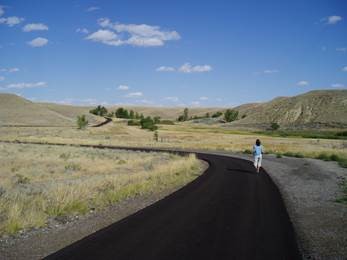Building Active Communities Initiative (BACI)
The Montana Nutrition and Physical Activity (NAPA) Program’s Building Active Communities Initiative (BACI)’s mission is to make active living and healthy eating easier everywhere Montanans live, work, learn and play.
Healthy Communities - Built Environment and Active Communities
Obesity and sedentary lifestyles are major contributors to chronic disease for both
adults and children. In 2011, nearly two-thirds (60%) of Montana adults were overweight
or obese and nearly half (45%) did not meet recommendations for aerobic activity.i In that same year, over 40 percent of Montana 7th and 8th grade students and 70
percent of Montana high school students did not get the recommended 60 minutes of
daily physical activity necessary for health and to reduce their risk of chronic disease.

Shelby Trail in Shelby, MT
It is clear that the way we design our communities—our buildings, landscapes, streets and neighborhoods—influence the way we live and therefore can affect our health and well-being. Adopting healthy behaviors, such as physical activity, is easier if our environment is built to support us in making healthy choices.
An active community is a place where it is easy and safe for people of all ages and abilities to walk, use a wheelchair or assistive device, bike or take public transportation for their everyday routines. These routines may include walking to school; commuting by bus to work; or doing everyday errands by bike. It is also a place where children can safely ride their bikes to a nearby park; seniors can stay in their homes as they age and still get around without having to drive; and children with disabilities can play with their friends on inclusive playgrounds and schoolyards built to accommodate everyone’s needs.
Local policy decisions governing the built environment (transportation, land use, and community design), influence many aspects of our daily lives:
- safety and attractiveness of neighborhoods
- distances people travel for work, school, recreation, shopping, and to reach other destinations
- transportation and housing options
- economic and environmental resiliency of the local economy
- convenience of purchasing (or growing) healthy foods
The Montana Nutrition and Physical Activity (NAPA) Program’s Building Active Communities Initiative (BACI) is a project of the Montana Department of Public Health and Human Services
in cooperation with Montana State University’s Office of Rural Health. With in-depth,
interactive training, mentoring and ongoing technical assistance, NAPA’s Building
Active Communities Initiative supports community-led approaches to develop active
and healthy communities.
Last year (2015), NAPA conducted a series of focus groups of 2013 and 2014 BACI teams.
During these sessions it was determined that communities were interested in a 2.0
version of the BACI Action Institute aimed at practical implementation strategies
for improving communities for active living.
2016 BACI Action Institute 2.0
March 22-24 in Great Falls Montana
This year, the DPPHS-NAPA Program hosted the 2-day Action Institute (spanning three
days) in Great Falls at the Celtic Cowboy Dark Horse Hall & the Mansfield Center for
the Performing Arts Missouri Room - March 22-24. Our Sponsers included: the Montana
Department of Commerce, Montana Department of Transportation, Western Transportation
Institute and Montana State Parks. Awarded Teams were provided lodging, meals/per
diem, travel costs and various networking opportunities.
Nationally-recognized experts: Gary Toth, a Senior Director from the Project for Public Spaces and Mike Lydon, Principal with Street Plans Collaborative for helping facilitate the 2.0 Institute. In addition to BACI Advisors,
Action Institute 2.0 Materials & Resources
For questions or more information on Montana’s Building Active Communities Initiative, contact: Cathy Costakis, Senior Consultant - Built Environment, NAPA, at costakis@montana.edu or (406) 994-5734.


